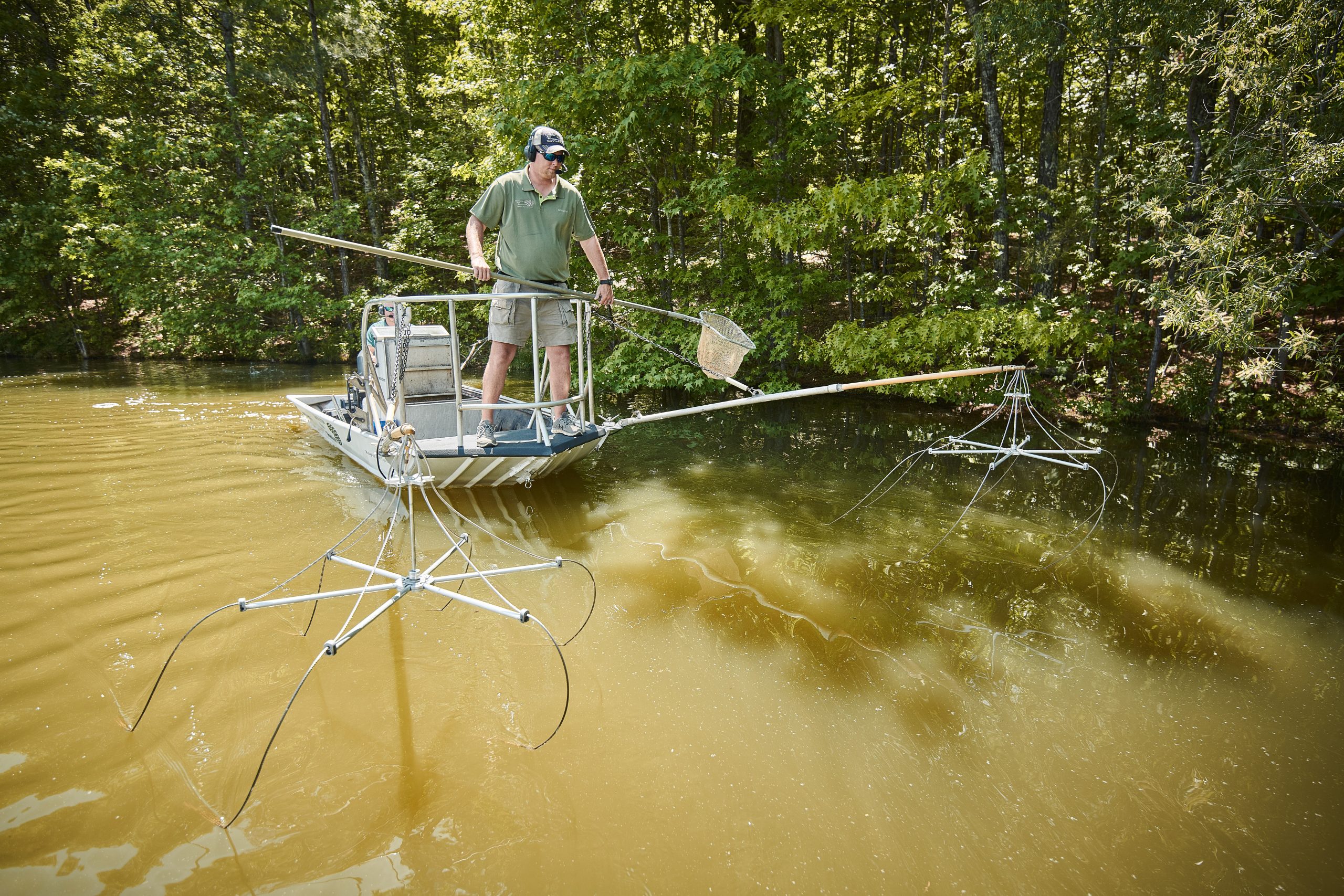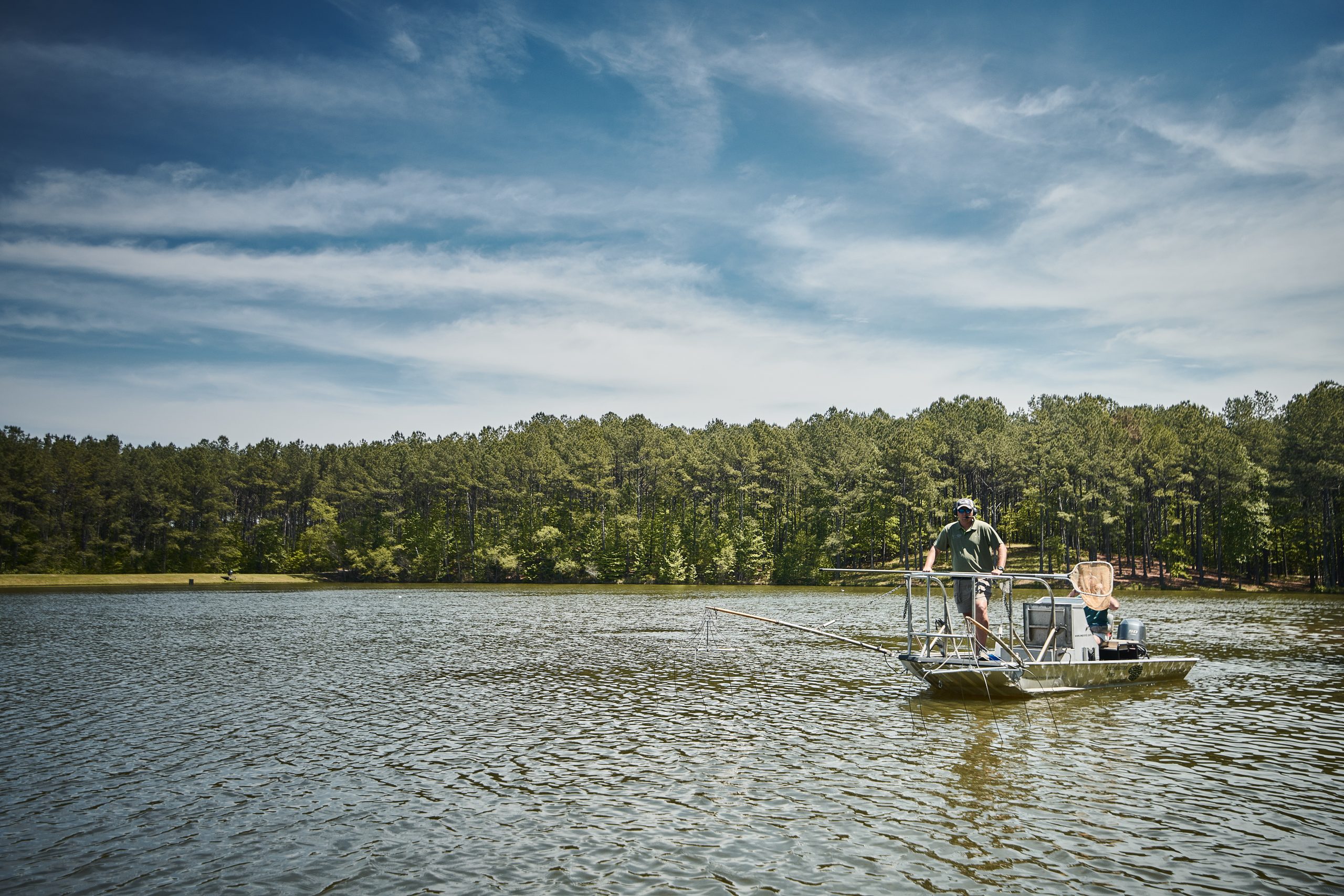Many of the most common questions that we receive at the Alabama Freshwater Fishing Report podcast are from fishing pond and small lake owners who ask: “What is involved in trophy pond management for big bass?”, “How do we grow trophy bass?”, “What southern pond management companies near me can help me create a trophy pond management plan?”, “Where do I go for pond construction and management help?”
While the questions sound simple and straightforward enough, the answers are a bit more entailed and complicated. To address these issues, we reached out to Norman Latona, owner of Southeastern Pond Management in Calera, AL.
SEPOND specializes in pond management services, including developing management programs and implementation strategy and steps, fertilizing and liming, weed control, electrofishing, fish stocking, pond design and construction and more.
According to Latona, whether it is for a new pond owner or someone who wants to reclaim an old pond, they need to do a full assessment of the pond to establish aquatic ecosystem baseline data. That includes establishing fish population and health (via electrofishing) availability of forage, water characteristics, the physical characteristics of the lake and the surrounding watershed and other benchmark data.
“We look at the physical characteristics of the lake and the surrounding watershed,” Latona said. “That includes the vegetation, the shape of the shoreline, account of structure or cover, natural and artificial habitat. Once all the data is collected, we summarize it and, based on the objectives and goals of the owner, we produce a trophy pond management plan for big bass.
Once Southeastern Pond Management produces a “snapshot in time”, taking into consideration what the owner wants to accomplish, it creates an action plan, outlining a series of steps to be implemented. Latona has found that it normally takes between 12 and 18 months to hit the established goal.
“It’s a snapshot of what the situation looks right now and we determine what needs to be done over the next year or so to create conditions more favorable to produce the largemouth bass pond management results the owners want,” Norman said. “It’s kind of like going to the doctor and having a physical so you know future treatment should progress.”
The central component of this information gathering component utilizes electrofishing technology which allows Southeastern Pond Management to safely and effectively sample the pond’s fish population, check alkalinity and do an aquatic weed assessment. He emphasized that the process doesn’t harm the fishing population, it just stuns fish swimming in a 6-8-foot radius of the booms. It’s like an underwater “stun gun”. This allows them to be netted, counted, measured or even culled if the bass population needs to be brought into balance with the forage and carrying capacity of the pond.

In terms of what is the best time to start a pond management plan, Latona said that while most of Southeastern Pond Management’s electrofishing efforts occur in the warmer months, starting a program in the colder months isn’t an issue.
“We can electrofish year-round and the only issue is that it may be a little more difficult to get access to properties with equipment in December and January as opposed to March and April and we take into consideration what is happening in the resource at that time of year and adjust accordingly,” Latona said. “We’ve been doing largemouth bass pond management like this for over 30 years and we know what we are looking for. If we shock in January, we don’t expect to see evidence of fresh bass reproduction. On the other hand, if we shocked in May or early June and we didn’t see bass fry, that would be noteworthy.”
Latona emphasized that because spring and fall are critical times for fish growth, getting the ball rolling in late February or end of summer allows you to achieve maximum results in your trophy pond management for big bass.
“We can start our largemouth bass pond management in the early spring and get the liming and fertilization programs cranked up. If we need to do some harvesting to reduce the predator population or add forage such as threadfin shad, we can start working on that and make sure all is in sync with optimum growth periods.”
While most pond construction and management plans call for a 12 – 18-month time frame for a completed management program and measurable results a lot depends on how efficiently the owner implements the recommendations.
“Fixing a pond is a little bit like fixing a watch with a sledge hammer and you have to create a little havoc and upheaval in the fish community,” Latona said. “Let’s say you have a ten-acre lake that is heavily bass crowded so we pulled out 350 pounds of fish, preferably in the 10-14-inch range and then added forage.”
“What you have done is dramatically reduced the number of bass that you are trying to feed and, at the same time, increased the food supply. If we did this in March, without question you would see measurable results, as in plumper fish, by the end of summer,” Latona said. “The more efficiently you put in place the management inputs, the more dramatic the results and our expectation would be significant results within the first year.”
On the other hand, Latona cautioned that trying to “piecemeal” pond construction and management just “cherry picking” different steps very rarely produces the outcome that an incremental, priority-based action step management program would. An example would just be dumping more forage fish into a pond hoping that all the additional food will fatten up the bass but not harvesting fish, liming or fertilizing.
“Just stocking more forage fish won’t necessarily result in bigger bass since it doesn’t address the interrelated dynamics of the pond and it would be very expensive on an on-going basis,” Latona said. “It takes about ten pounds of food to grow a pound on a bass and if all you did was feed them, in a bass crowded pond, with hundreds and thousands of little 4-10-inch fish, you’d go broke. There is a carrying capacity as to how many fish you can grow in that pond but it depends on what you want. If your goal is bigger bass just doing 50% of the recommendations won’t get you there.”

“I look at it as a candle that has a wick on both ends with our goal slapped right in the middle of it. We can start harvesting bass and that lights one end of it. If we add forage that lights the other end of the candle and, once that happens, we are going to be more efficient in achieving our goal which is bigger bass,” Latona pointed out.
“When considering pond construction and management, we also prioritize by levels of importance where level one is a critically important component such as harvesting whereas level three may be introducing structure or habitat but level three isn’t something really mission critical in order to achieve the stated objective,” he said.
While Southeastern Pond can provide a total “turnkey” trophy pond management program for big bass, they work with “Do-it-Yourselfers” to provide individual components and materials.
“There are a number of things that pond owners can do on their own and we are more than happy to provide material and fish, specific services like liming or fertilizing, technical expertise and advice and guidance,” Latona said.
Latona pointed out that the one area that can be a challenge to DIY pond owners who use hook and line fishing to harvest excess simply because of the volume. When implementing a proper largemouth bass pond management plan, he says that the rule of thumb for fish harvests in bass crowded ponds is between 30-35 pounds and up per acre.
“For a 10-acre lake that means you need to pull about 350 pounds of fish out and for a 30-acre pond that is about 1,000 pounds of bass. That is a lot of fishing for 2,3 or even four people,” Latona said. “That is where electrofishing harvest can help and save pond owners a lot of time and effort.”
Important Contact Info
Southeastern Pond Management
334-887-7663




